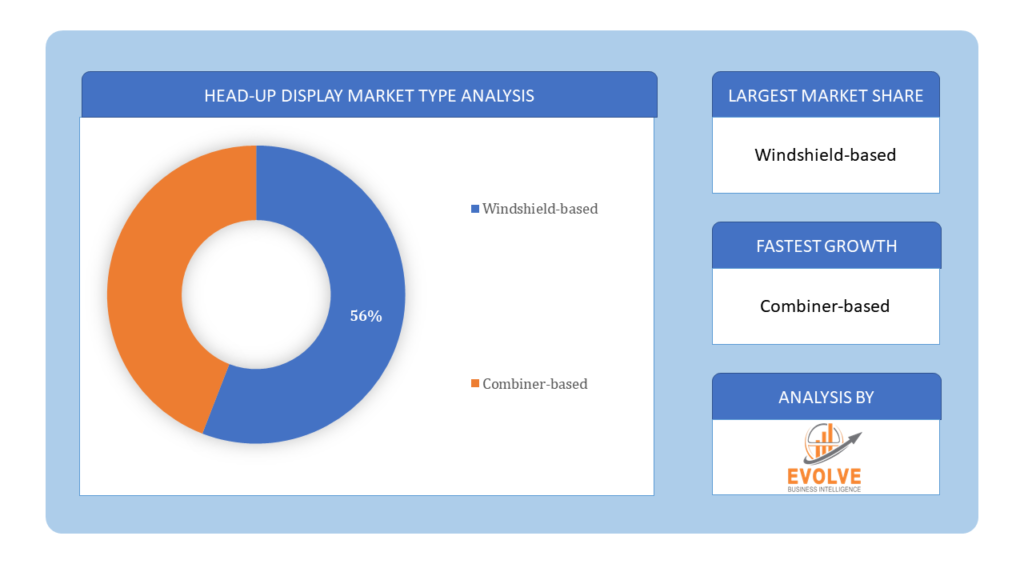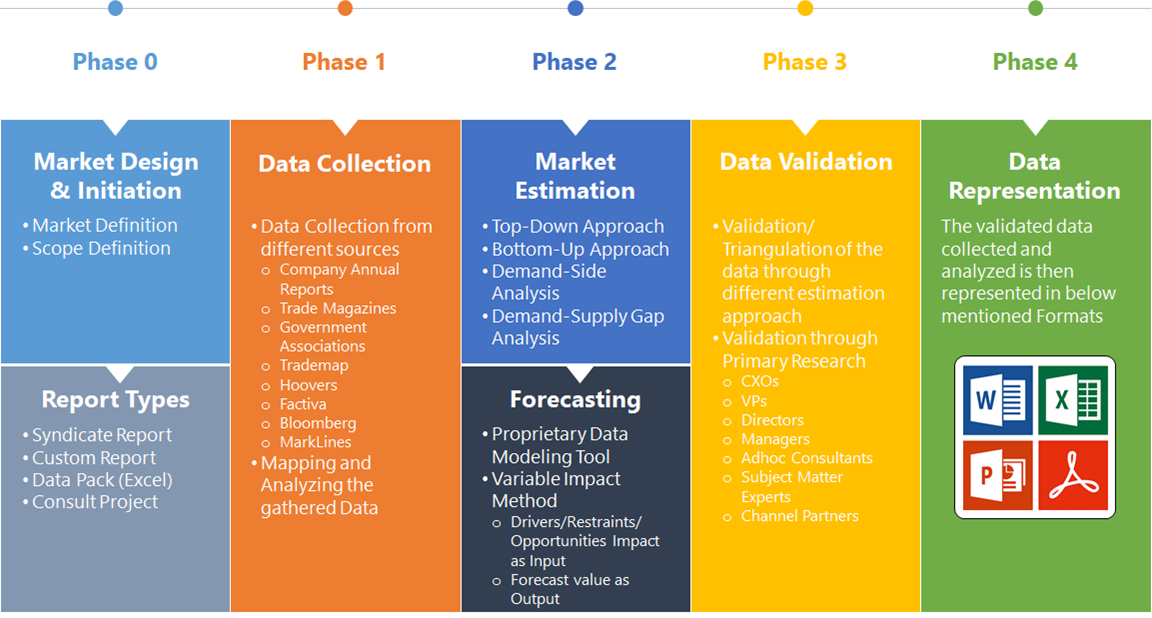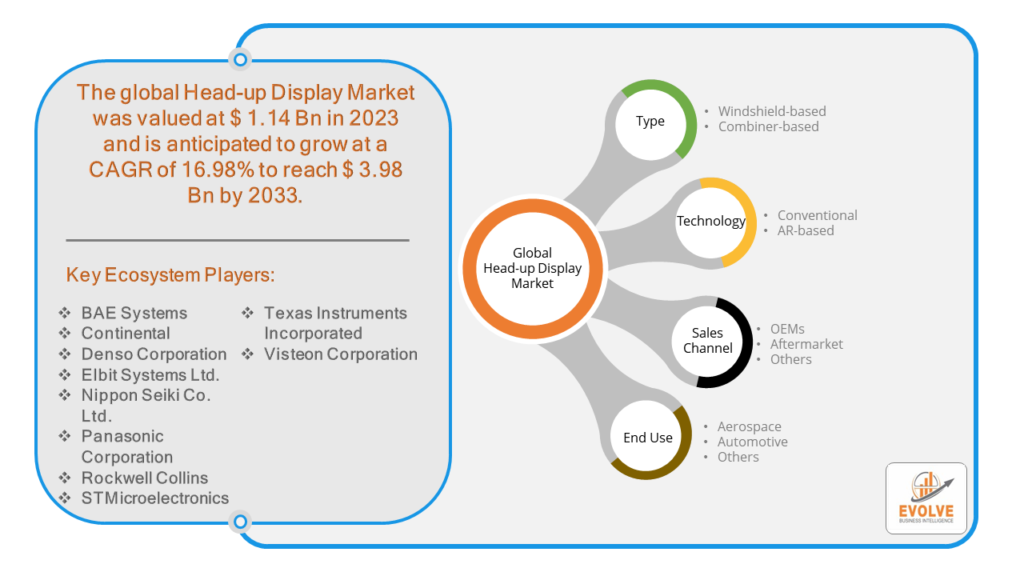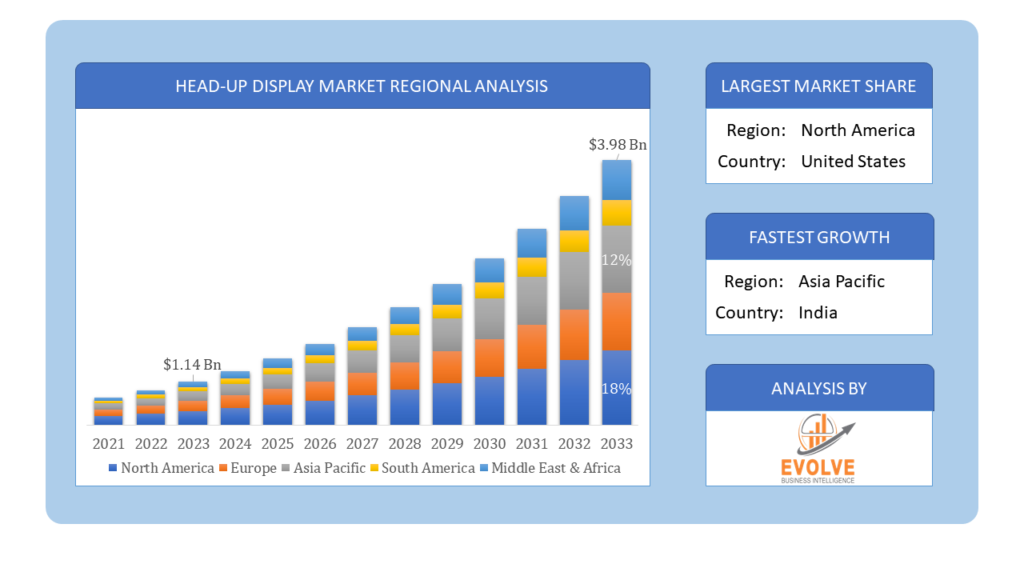Head-up Display Market Analysis and Global Forecast 2023-2033
$ 1,390.00 – $ 5,520.00Price range: $ 1,390.00 through $ 5,520.00
Head-up Display Market Research Report: Information By Type (Windshield-based, Combiner-based), By Technology (Conventional, AR-based), By Sales Channel (OEMs, Aftermarket, Others), By End-Use (Aerospace, Automotive Others), and by Region — Forecast till 2033
Page: 158
Head-up Display Market Overview
The Head-up Display Market Size is expected to reach USD 3.98 Billion by 2033. The Head-up Display Market industry size accounted for USD 1.14 Billion in 2023 and is expected to expand at a compound annual growth rate (CAGR) of 16.98% from 2023 to 2033. The Head-up Display (HUD) Market refers to the industry focused on the development, production, and sales of head-up display systems. These systems project information, such as speed, navigation, and other critical data, directly onto a transparent display, typically on the windshield or a combiner, allowing users to view information without diverting their gaze from their usual viewpoints.
Overall, the HUD market is growing due to the increasing emphasis on vehicle and aircraft safety, technological advancements, and the rising demand for connected and autonomous vehicles.
Global Head-up Display Market Synopsis
The COVID-19 pandemic had significant impacts on the Head-up Display (HUD) market. The pandemic caused significant disruptions in global supply chains, affecting the production and delivery of HUD components. Manufacturing plants faced shutdowns or reduced operations, leading to delays and shortages. The automotive industry, a major consumer of HUDs, saw a significant decline in sales during the initial phases of the pandemic. This decline was due to reduced consumer spending, economic uncertainty, and lockdown measures, leading to decreased demand for new vehicles equipped with HUDs. The pandemic highlighted the importance of safety and automation in vehicles. As a result, there is an increased interest in advanced driver-assistance systems (ADAS) and features like HUDs that enhance driver safety and convenience. The pandemic has accelerated digital transformation across industries. In the HUD market, this has led to increased investment in research and development for more advanced, augmented reality HUDs, and improved user interfaces.
Head-up Display Market Dynamics
The major factors that have impacted the growth of Head-up Display Market are as follows:
Drivers:
Ø Technological Advancements
Innovations in display technologies, such as augmented reality (AR) and holographic projections, are making HUDs more effective and appealing. Modern HUDs are increasingly integrated with ADAS, providing real-time information such as lane departure warnings, collision alerts, and speed limit recognition. HUDs enhance driver safety by allowing them to keep their eyes on the road while viewing critical information. This reduces distractions and improves reaction times. The growing adoption of ADAS features like adaptive cruise control, lane-keeping assistance, and automatic emergency braking is driving the demand for HUDs that can display ADAS information seamlessly. Increasing consumer awareness and demand for safety features in vehicles are encouraging manufacturers to include HUDs.
Restraint:
- Perception of High Costs
The manufacturing and integration of HUD systems involve high costs due to the sophisticated technology and materials required, making them expensive for both manufacturers and consumers. Many consumers, especially in emerging markets, are price-sensitive and may opt for vehicles without HUDs to reduce costs. This limits the market potential in these regions. Despite the benefits of HUDs, many consumers are still unaware of their existence or advantages, which affects adoption rates.
Opportunity:
⮚ Increasing Vehicle Safety Requirements
Stringent safety regulations are driving the adoption of HUDs in vehicles, as they improve driver safety by reducing distraction and providing critical information without diverting attention from the road. HUDs are increasingly integrated with ADAS features like lane departure warning systems, collision avoidance alerts, and adaptive cruise control, further enhancing safety. The integration of HUDs with connected car services can provide real-time traffic updates, weather information, and personalized recommendations to drivers, enhancing convenience and safety. HUDs play a crucial role in autonomous vehicles by providing passengers with real-time information about the vehicle’s status, route, and surroundings. There is a growing demand for HUDs in premium and luxury vehicles, where they are increasingly offered as standard or optional features to enhance the driving experience and differentiate from competitors.
Head-up Display Market Segment Overview
By Type
 Based on Type, the market is segmented based on Windshield-based and Combiner-based. The Windshield-based segment dominant the market. A windshield HUD is integrated directly into the windshield of the vehicle. Information is projected onto the windshield itself, which provides drivers with the necessary data within their natural line of sight. This eliminates the need for any additional screens or displays within the vehicle. These types of HUDs are often found in high-end vehicles and offer the advantage of a cleaner, less cluttered dashboard.
Based on Type, the market is segmented based on Windshield-based and Combiner-based. The Windshield-based segment dominant the market. A windshield HUD is integrated directly into the windshield of the vehicle. Information is projected onto the windshield itself, which provides drivers with the necessary data within their natural line of sight. This eliminates the need for any additional screens or displays within the vehicle. These types of HUDs are often found in high-end vehicles and offer the advantage of a cleaner, less cluttered dashboard.
By Technology
Based on Technology, the market segment has been divided into the Conventional and AR-based. The Conventional segment dominant the market. Conventional HUDs are the traditional form of this technology, which displays basic information directly in the line of sight of the user. They generally project simple data like speed, fuel levels, and basic navigation directions onto a transparent surface, such as a windshield or a combiner glass. Conventional HUDs are often less expensive and easier to install, making them accessible for most vehicle owners. These HUDs aim to minimize distractions by presenting crucial data within easy view, thereby improving safety and operational efficiency.
By Sales Channel
Based on Sales Channel, the market segment has been divided into the OEMs, Aftermarket and Others. The Aftermarket segment dominant the market.
By End Use
Based on End Use, the market segment has been divided into the Aerospace, Automotive and Others. The automotive segment dominant the market. The market expansion for these displays is anticipated to be driven by the rising integration of head-up displays with driver assistance systems, which is being adopted by a number of automakers. Additionally, the industry is growing because to the quick development of technology and the incorporation of artificial intelligence (AI) into automotive systems.
Global Head-up Display Market Regional Analysis
Based on region, the global Head-up Display Market has been divided into North America, Europe, Asia-Pacific, the Middle East & Africa, and Latin America. North America is projected to dominate the use of the Head-up Display Market followed by the Asia-Pacific and Europe regions.
 Head-up Display North America Market
Head-up Display North America Market
North America holds a dominant position in the Head-up Display Market. United States and Canada has high adoption of advanced automotive technologies, stringent safety regulations, and presence of major automotive manufacturers. Dominance in automotive and aviation sectors, with significant investments in ADAS and connected vehicle technologies. Growth in luxury and premium vehicle segments, increasing demand for AR HUDs, and expansion into military applications.
Head-up Display Asia-Pacific Market
The Asia-Pacific region has indeed emerged as the fastest-growing market for the Head-up Display Market industry. China, Japan, South Korea is growing market for both passenger vehicles and commercial vehicles equipped with HUDs, expansion of AR HUD technology. Rapid economic growth, increasing automotive production, and government support for automotive innovation. Rising disposable incomes, adoption of electric vehicles, and integration of HUDs with connected vehicle services.
Competitive Landscape
The global Head-up Display Market is highly competitive, with numerous players offering a wide range of software solutions. The competitive landscape is characterized by the presence of established companies, as well as emerging startups and niche players. To increase their market position and attract a wide consumer base, the businesses are employing various strategies, such as product launches, and strategic alliances.
Prominent Players:
- BAE Systems
- Continental
- Denso Corporation
- Elbit Systems Ltd.
- Nippon Seiki Co. Ltd.
- Panasonic Corporation
- Rockwell Collins
- STMicroelectronics
- Texas Instruments Incorporated
- Visteon Corporation
Key Development
In June 2023, the heads-up display (HUD) assets of Saab were acquired by Honeywell International Inc. as part of a strategic move to strengthen its avionics portfolio. This acquisition sets the stage for Honeywell and Saab to work together to advance and expand the use of HUD technology across their product range. Aviation safety is greatly enhanced by heads-up displays, which are widely acknowledged for their vital function in enhancing pilots’ situational awareness, particularly in inclement weather or low-light conditions. The goal of Honeywell and Saab’s collaboration is to further utilize this technology to promote safer and more fuel-efficient aviation.
Scope of the Report
Global Head-up Display Market, by Type
- Windshield-based
- Combiner-based
Global Head-up Display Market, by Technology
- Conventional
- AR-based
Global Head-up Display Market, by Sales Channel
- OEMs
- Aftermarket
- Others
Global Head-up Display Market, by End Use
- Aerospace
- Automotive
- Others
Global Head-up Display Market, by Region
- North America
- US
- Canada
- Mexico
- Europe
- UK
- Germany
- France
- Italy
- Spain
- Benelux
- Nordic
- Rest of Europe
- Asia Pacific
- China
- Japan
- South Korea
- Indonesia
- Austalia
- Malaysia
- India
- Rest of Asia Pacific
- South America
- Brazil
- Argentina
- Rest of South America
- Middle East & Africa
- Saudi Arabia
- UAE
- Egypt
- South Africa
- Rest of Middle East & Africa
| Parameters | Indicators |
|---|---|
| Market Size | 2033: $3.98 Billion |
| CAGR | 16.98% CAGR (2023-2033) |
| Base year | 2022 |
| Forecast Period | 2023-2033 |
| Historical Data | 2021 |
| Report Coverage | Revenue Forecast, Competitive Landscape, Growth Factors, and Trends |
| Key Segmentations | Type, Technology, Sales Channel, End Use |
| Geographies Covered | North America, Europe, Asia-Pacific, Latin America, Middle East, Africa |
| Key Vendors | BAE Systems, Continental, Denso Corporation, Elbit Systems Ltd., Nippon Seiki Co. Ltd., Panasonic Corporation, Rockwell Collins, STMicroelectronics, Texas Instruments Incorporated and Visteon Corporation. |
| Key Market Opportunities | • Increasing Vehicle Safety Requirements • Growth in Connected and Autonomous Vehicles |
| Key Market Drivers | • Technological Advancements • Rising Adoption of Advanced Driver-Assistance Systems (ADAS) |
REPORT CONTENT BRIEF:
- High-level analysis of the current and future Head-up Display Market trends and opportunities
- Detailed analysis of current market drivers, restraining factors, and opportunities in the future
- Head-up Display Market historical market size for the year 2021, and forecast from 2023 to 2033
- Head-up Display Market share analysis at each product level
- Competitor analysis with detailed insight into its product segment, Government & Defense strength, and strategies adopted.
- Identifies key strategies adopted including product launches and developments, mergers and acquisitions, joint ventures, collaborations, and partnerships as well as funding taken and investment done, among others.
- To identify and understand the various factors involved in the global Head-up Display Market affected by the pandemic
- To provide a detailed insight into the major companies operating in the market. The profiling will include the Government & Defense health of the company’s past 2-3 years with segmental and regional revenue breakup, product offering, recent developments, SWOT analysis, and key strategies.
Press Release

Global Pharmaceutical Manufacturing Market to Reach $1.38 Trillion by 2035 with 7.35% CAGR, New Research Shows

The Global Mammography Market Is Estimated To Record a CAGR of Around 10.29% During The Forecast Period

Glue Stick Market to Reach USD 2.35 Billion by 2034

Podiatry Service Market to Reach USD 11.88 Billion by 2034

Microfluidics Technology Market to Reach USD 32.58 Billion by 2034

Ferric Chloride Market to Reach USD 10.65 Billion by 2034

Family Practice EMR Software Market to Reach USD 21.52 Billion by 2034

Electric Hairbrush Market to Reach USD 15.95 Billion by 2034

Daily Bamboo Products Market to Reach USD 143.52 Billion by 2034

Cross-border E-commerce Logistics Market to Reach USD 112.65 Billion by 2034
Frequently Asked Questions (FAQ)
1.What is the study period of this market?
- The study period of the global Head-up Display Market is 2021- 2033
2.What is the growth rate of the global Head-up Display Market?
- The global Head-up Display Market is growing at a CAGR of 16.98% over the next 10 years
3.Which region has the highest growth rate in the market of Head-up Display Market?
- Asia Pacific is expected to register the highest CAGR during 2023-2033
4.Which region has the largest share of the global Head-up Display Market?
- North America holds the largest share in 2022
5.Who are the key players in the global Head-up Display Market?
BAE Systems, Continental, Denso Corporation, Elbit Systems Ltd., Nippon Seiki Co. Ltd., Panasonic Corporation, Rockwell Collins, STMicroelectronics, Texas Instruments Incorporated and Visteon Corporation. are the major companies operating in the market
6.Do you offer Post Sale Support?
- Yes, we offer 16 hours of analyst support to solve the queries
7.Do you sell particular sections of a report?
Yes, we provide regional as well as country-level reports. Other than this we also provide a sectional report. Please get in contact with our sales representatives
Table of Content
CHAPTER 1. Executive Summary CHAPTER 2. Scope of the Study 2.1. Market Definition 2.2. Market Scope & Segmentation 2.2.1. Objective of Report CHAPTER 3. Evolve BI Methodology 3.1. Data Collection & Validation Approach 3.2. Market Size Estimation and Forecast CHAPTER 4. Exclusive Analysis 4.1. Market Opportunity Score 4.1.1. Type Segement – Market Opportunity Score 4.1.2. Technology Segment – Market Opportunity Score 4.1.3. Sales Channel Segment – Market Opportunity Score 4.1.4. End Use Segment – Market Opportunity Score 4.2. Key Market Influencing Indicators CHAPTER 5. Market Insights and Trends 5.1. Value Chain Analysis 5.1.1. Raw Material 5.1.2. Manufacturing Process 5.1.3. Distribution Channel 5.1.4. End Users 5.2. Porter’s Five Forces Analysis 5.2.1. Bargaining Power of Buyers 5.2.2. Bargaining Power of Suppliers 5.2.3. Threat of New Entrant 5.2.4. Threat of Substitute 5.2.5. Industry Rivalry 5.3. COVID-19 Impact and Post COVID Scenario on Head-up Display Market 5.3.1. Impact of COVID-19 5.3.2. Government Support and Industry Revival Policies 5.3.3. Measures Taken by Companies to Mitigate Negative Impact 5.3.4. Post COVID Trend CHAPTER 6. MArket Dynamics 6.1. Introduction 6.2. Drivers 6.2.1. Driver 1 6.2.2. Driver 2 6.2.3. Driver 3 6.3. Restraints 6.3.1. Restraint 1 6.3.2. Restraint 2 6.4. Opportunity 6.4.1. Opportunity 1 CHAPTER 7. Head-up Display Market, By Type 7.1. Introduction 7.1.1. Windshield-based 7.1.2. Combiner-based CHAPTER 8. Head-up Display Market, By Technology 8.1. Introduction 8.1.1. Conventional 8.1.2. AR-based CHAPTER 9. Head-up Display Market, By Sales Channel 9.1. Introduction 9.1.1. OEMs 9.1.2. Aftermarket 9.1.3 Others CHAPTER 10. Head-up Display Market, By End Use 10.1.Introduction 10.1.1. Aerospace 10.1.2. Automotive 10.1.3. Others CHAPTER 11. Head-up Display Market, By Region 11.1. Introduction 11.2. NORTH AMERICA 11.2.1. North America: Market Size and Forecast, By Country, 2023 – 2033 ($ Million) 11.2.2. North America: Market Size and Forecast, By Type, 2023 – 2033 ($ Million) 11.2.3. North America: Market Size and Forecast, By Technology, 2023 – 2033 ($ Million) 11.2.4. North America: Market Size and Forecast, By Sales Channel, 2023 – 2033 ($ Million) 11.2.5. North America: Market Size and Forecast, By End Use, 2023 – 2033 ($ Million) 11.2.6. US 11.2.6.1. US: Market Size and Forecast, By Type, 2023 – 2033 ($ Million) 11.2.6.2. US: Market Size and Forecast, By Technology, 2023 – 2033 ($ Million) 11.2.6.3. US: Market Size and Forecast, By Sales Channel, 2023 – 2033 ($ Million) 11.2.6.4. US: Market Size and Forecast, By End Use, 2023 – 2033 ($ Million) 11.2.7. CANADA 11.2.7.1. Canada: Market Size and Forecast, By Type, 2023 – 2033 ($ Million) 11.2.7.2. Canada: Market Size and Forecast, By Technology, 2023 – 2033 ($ Million) 11.2.7.3. Canada: Market Size and Forecast, By Sales Channel, 2023 – 2033 ($ Million) 11.2.7.4. Canada: Market Size and Forecast, By End Use, 2023 – 2033 ($ Million) 11.2.8. MEXICO 11.2.8.1. Mexico: Market Size and Forecast, By Type, 2023 – 2033 ($ Million) 11.2.8.2. Mexico: Market Size and Forecast, By Technology, 2023 – 2033 ($ Million) 11.2.8.3. Mexico: Market Size and Forecast, By Sales Channel, 2023 – 2033 ($ Million) 11.2.8.4. Mexico: Market Size and Forecast, By End Use, 2023 – 2033 ($ Million) 11.3. Europe 11.3.1. Europe: Market Size and Forecast, By Country, 2023 – 2033 ($ Million) 11.3.2. Europe: Market Size and Forecast, By Type, 2023 – 2033 ($ Million) 11.3.3. Europe: Market Size and Forecast, By Technology, 2023 – 2033 ($ Million) 11.3.4. Europe: Market Size and Forecast, By Sales Channel, 2023 – 2033 ($ Million) 11.3.5. Europe: Market Size and Forecast, By End Use, 2023 – 2033 ($ Million) 11.3.6. U.K. 11.3.6.1. U.K.: Market Size and Forecast, By Type, 2023 – 2033 ($ Million) 11.3.6.2. U.K.: Market Size and Forecast, By Technology, 2023 – 2033 ($ Million) 11.3.6.3. U.K.: Market Size and Forecast, By Sales Channel, 2023 – 2033 ($ Million) 11.3.6.4. U.K.: Market Size and Forecast, By End Use, 2023 – 2033 ($ Million) 11.3.7. GERMANY 11.3.7.1. Germany: Market Size and Forecast, By Type, 2023 – 2033 ($ Million) 11.3.7.2. Germany: Market Size and Forecast, By Technology, 2023 – 2033 ($ Million) 11.3.7.3. Germany: Market Size and Forecast, By Sales Channel, 2023 – 2033 ($ Million) 11.3.7.4. Germany: Market Size and Forecast, By End Use, 2023 – 2033 ($ Million) 11.3.8. FRANCE 11.3.8.1. France: Market Size and Forecast, By Type, 2023 – 2033 ($ Million) 11.3.8.2. France: Market Size and Forecast, By Technology, 2023 – 2033 ($ Million) 11.3.8.3. France: Market Size and Forecast, By Sales Channel, 2023 – 2033 ($ Million) 11.3.8.4. France: Market Size and Forecast, By End Use, 2023 – 2033 ($ Million) 11.3.9. ITALY 11.3.9.1. Italy: Market Size and Forecast, By Type, 2023 – 2033 ($ Million) 11.3.9.2. Italy: Market Size and Forecast, By Technology, 2023 – 2033 ($ Million) 11.3.9.3. Italy: Market Size and Forecast, By Sales Channel, 2023 – 2033 ($ Million) 11.3.9.4. Italy: Market Size and Forecast, By End Use, 2023 – 2033 ($ Million) 11.3.10. SPAIN 11.3.10.1. Spain: Market Size and Forecast, By Type, 2023 – 2033 ($ Million) 11.3.10.2. Spain: Market Size and Forecast, By Technology, 2023 – 2033 ($ Million) 11.3.10.3. Spain: Market Size and Forecast, By Sales Channel, 2023 – 2033 ($ Million) 11.3.10.4. Spain: Market Size and Forecast, By End Use, 2023 – 2033 ($ Million) 11.3.11. BENELUX 11.3.11.1. BeNeLux: Market Size and Forecast, By Type, 2023 – 2033 ($ Million) 11.3.11.2. BeNeLux: Market Size and Forecast, By Technology, 2023 – 2033 ($ Million) 11.3.11.3. BeNeLux: Market Size and Forecast, By Sales Channel, 2023 – 2033 ($ Million) 11.3.11.4. BeNeLux: Market Size and Forecast, By End Use, 2023 – 2033 ($ Million) 11.3.12. RUSSIA 11.3.12.1. Russia: Market Size and Forecast, By Type, 2023 – 2033 ($ Million) 11.3.12.2. Russia: Market Size and Forecast, By Technology, 2023 – 2033 ($ Million) 11.3.12.3. Russia: Market Size and Forecast, By Sales Channel, 2023 – 2033 ($ Million) 11.3.12.4. Russia: Market Size and Forecast, By End Use, 2023 – 2033 ($ Million) 11.3.13. REST OF EUROPE 11.3.13.1. Rest of Europe: Market Size and Forecast, By Type, 2023 – 2033 ($ Million) 11.3.13.2. Rest of Europe: Market Size and Forecast, By Technology, 2023 – 2033 ($ Million) 11.3.13.3. Rest of Europe: Market Size and Forecast, By Sales Channel, 2023 – 2033 ($ Million) 11.3.13.4. Rest of Europe: Market Size and Forecast, By End Use, 2023 – 2033 ($ Million) 11.4. Asia Pacific 11.4.1. Asia Pacific: Market Size and Forecast, By Country, 2023 – 2033 ($ Million) 11.4.2. Asia Pacific: Market Size and Forecast, By Type, 2023 – 2033 ($ Million) 11.4.3. Asia Pacific: Market Size and Forecast, By Technology, 2023 – 2033 ($ Million) 11.4.4. Asia Pacific: Market Size and Forecast, By Sales Channel, 2023 – 2033 ($ Million) 11.4.5. Asia Pacific: Market Size and Forecast, By End Use, 2023 – 2033 ($ Million) 11.4.6. CHINA 11.4.6.1. China: Market Size and Forecast, By Type, 2023 – 2033 ($ Million) 11.4.6.2. China: Market Size and Forecast, By Technology, 2023 – 2033 ($ Million) 11.4.6.3. China: Market Size and Forecast, By Sales Channel, 2023 – 2033 ($ Million) 11.4.6.4. China: Market Size and Forecast, By End Use, 2023 – 2033 ($ Million) 11.4.7. JAPAN 11.4.7.1. Japan: Market Size and Forecast, By Type, 2023 – 2033 ($ Million) 11.4.7.2. Japan: Market Size and Forecast, By Technology, 2023 – 2033 ($ Million) 11.4.7.3. Japan: Market Size and Forecast, By Sales Channel, 2023 – 2033 ($ Million) 11.4.7.4. Japan: Market Size and Forecast, By End Use, 2023 – 2033 ($ Million) 11.4.8. INDIA 11.4.8.1. India: Market Size and Forecast, By Type, 2023 – 2033 ($ Million) 11.4.8.2. India: Market Size and Forecast, By Technology, 2023 – 2033 ($ Million) 11.4.8.3. India: Market Size and Forecast, By Sales Channel, 2023 – 2033 ($ Million) 11.4.8.4. India: Market Size and Forecast, By End Use, 2023 – 2033 ($ Million) 11.4.9. SOUTH KOREA 11.4.9.1. South Korea: Market Size and Forecast, By Type, 2023 – 2033 ($ Million) 11.4.9.2. South Korea: Market Size and Forecast, By Technology, 2023 – 2033 ($ Million) 11.4.9.3. South Korea: Market Size and Forecast, By Sales Channel, 2023 – 2033 ($ Million) 11.4.9.4. South Korea: Market Size and Forecast, By End Use, 2023 – 2033 ($ Million) 11.4.10. THAILAND 11.4.10.1. Thailand: Market Size and Forecast, By Type, 2023 – 2033 ($ Million) 11.4.10.2. Thailand: Market Size and Forecast, By Technology, 2023 – 2033 ($ Million) 11.4.10.3. Thailand: Market Size and Forecast, By Sales Channel, 2023 – 2033 ($ Million) 11.4.10.4. Thailand: Market Size and Forecast, By End Use, 2023 – 2033 ($ Million) 11.4.11. INDONESIA 11.4.11.1. Indonesia: Market Size and Forecast, By Type, 2023 – 2033 ($ Million) 11.4.11.2. Indonesia: Market Size and Forecast, By Technology, 2023 – 2033 ($ Million) 11.4.11.3. Indonesia: Market Size and Forecast, By Sales Channel, 2023 – 2033 ($ Million) 11.4.11.4. Indonesia: Market Size and Forecast, By End Use, 2023 – 2033 ($ Million) 11.4.12. MALAYSIA 11.4.12.1. Malaysia: Market Size and Forecast, By Type, 2023 – 2033 ($ Million) 11.4.12.2. Malaysia: Market Size and Forecast, By Technology, 2023 – 2033 ($ Million) 11.4.12.3. Malaysia: Market Size and Forecast, By Sales Channel, 2023 – 2033 ($ Million) 11.4.12.4. Malaysia: Market Size and Forecast, By End Use, 2023 – 2033 ($ Million) 11.4.13. AUSTRALIA 11.4.13.1. Australia: Market Size and Forecast, By Type, 2023 – 2033 ($ Million) 11.4.13.2. Australia: Market Size and Forecast, By Technology, 2023 – 2033 ($ Million) 11.4.13.3. Australia: Market Size and Forecast, By Sales Channel, 2023 – 2033 ($ Million) 11.4.13.4. Australia: Market Size and Forecast, By End Use, 2023 – 2033 ($ Million) 11.4.14. REST FO ASIA PACIFIC 11.4.14.1. Rest fo Asia Pacific: Market Size and Forecast, By Type, 2023 – 2033 ($ Million) 11.4.14.2. Rest fo Asia Pacific: Market Size and Forecast, By Technology, 2023 – 2033 ($ Million) 11.4.14.3. Rest fo Asia Pacific: Market Size and Forecast, By Sales Channel, 2023 – 2033 ($ Million) 11.4.14.4. Rest fo Asia Pacific: Market Size and Forecast, By End Use, 2023 – 2033 ($ Million) 11.5. South America 11.5.1. South America: Market Size and Forecast, By Country, 2023 – 2033 ($ Million) 11.5.2. South America: Market Size and Forecast, By Type, 2023 – 2033 ($ Million) 11.5.3. South America: Market Size and Forecast, By Technology, 2023 – 2033 ($ Million) 11.5.4. South America: Market Size and Forecast, By Sales Channel, 2023 – 2033 ($ Million) 11.5.5. South America: Market Size and Forecast, By End Use, 2023 – 2033 ($ Million) 11.5.6. BRAZIL 11.5.6.1. Brazil: Market Size and Forecast, By Type, 2023 – 2033 ($ Million) 11.5.6.2. Brazil: Market Size and Forecast, By Technology, 2023 – 2033 ($ Million) 11.5.6.3. Brazil: Market Size and Forecast, By Sales Channel, 2023 – 2033 ($ Million) 11.5.6.4. Brazil: Market Size and Forecast, By End Use, 2023 – 2033 ($ Million) 11.5.7. ARGENTINA 11.5.7.1. Argentina: Market Size and Forecast, By Type, 2023 – 2033 ($ Million) 11.5.7.2. Argentina: Market Size and Forecast, By Technology, 2023 – 2033 ($ Million) 11.5.7.3. Argentina: Market Size and Forecast, By Sales Channel, 2023 – 2033 ($ Million) 11.5.7.4. Argentina: Market Size and Forecast, By End Use, 2023 – 2033 ($ Million) 11.5.8. REST OF SOUTH AMERICA 11.5.8.1. Rest of South America: Market Size and Forecast, By Type, 2023 – 2033 ($ Million) 11.5.8.2. Rest of South America: Market Size and Forecast, By Technology, 2023 – 2033 ($ Million) 11.5.8.3. Rest of South America: Market Size and Forecast, By Sales Channel, 2023 – 2033 ($ Million) 11.5.8.4. Rest of South America: Market Size and Forecast, By End Use, 2023 – 2033 ($ Million) 11.6. Middle East & Africa 11.6.1. Middle East & Africa: Market Size and Forecast, By Country, 2023 – 2033 ($ Million) 11.6.2. Middle East & Africa: Market Size and Forecast, By Type, 2023 – 2033 ($ Million) 11.6.3. Middle East & Africa: Market Size and Forecast, By Technology, 2023 – 2033 ($ Million) 11.6.4. Middle East & Africa: Market Size and Forecast, By Sales Channel, 2023 – 2033 ($ Million) 11.6.5. Middle East & Africa: Market Size and Forecast, By End Use, 2023 – 2033 ($ Million) 11.6.6. SAUDI ARABIA 11.6.6.1. Saudi Arabia: Market Size and Forecast, By Type, 2023 – 2033 ($ Million) 11.6.6.2. Saudi Arabia: Market Size and Forecast, By Technology, 2023 – 2033 ($ Million) 11.6.6.3. Saudi Arabia: Market Size and Forecast, By Sales Channel, 2023 – 2033 ($ Million) 11.6.6.4. Saudi Arabia: Market Size and Forecast, By End Use, 2023 – 2033 ($ Million) 11.6.7. UAE 11.6.7.1. UAE: Market Size and Forecast, By Type, 2023 – 2033 ($ Million) 11.6.7.2. UAE: Market Size and Forecast, By Technology, 2023 – 2033 ($ Million) 11.6.7.3. UAE: Market Size and Forecast, By Sales Channel, 2023 – 2033 ($ Million) 11.6.7.4. UAE: Market Size and Forecast, By End Use, 2023 – 2033 ($ Million) 11.6.8. EGYPT 11.6.8.1. Egypt: Market Size and Forecast, By Type, 2023 – 2033 ($ Million) 11.6.8.2. Egypt: Market Size and Forecast, By Technology, 2023 – 2033 ($ Million) 11.6.8.3. Egypt: Market Size and Forecast, By Sales Channel, 2023 – 2033 ($ Million) 11.6.8.4. Egypt: Market Size and Forecast, By End Use, 2023 – 2033 ($ Million) 11.6.9. SOUTH AFRICA 11.6.9.1. South Africa: Market Size and Forecast, By Type, 2023 – 2033 ($ Million) 11.6.9.2. South Africa: Market Size and Forecast, By Technology, 2023 – 2033 ($ Million) 11.6.9.3. South Africa: Market Size and Forecast, By Sales Channel, 2023 – 2033 ($ Million) 11.6.9.4. South Africa: Market Size and Forecast, By End Use, 2023 – 2033 ($ Million) 11.6.10. REST OF MIDDLE EAST & AFRICA 11.6.10.1. Rest of Middle East & Africa: Market Size and Forecast, By Type, 2023 – 2033 ($ Million) 11.6.10.2. Rest of Middle East & Africa: Market Size and Forecast, By Technology, 2023 – 2033 ($ Million) 11.6.10.3. Rest of Middle East & Africa: Market Size and Forecast, By Sales Channel, 2023 – 2033 ($ Million) 11.6.10.4. Rest of Middle East & Africa: Market Size and Forecast, By End Use, 2023 – 2033 ($ Million) CHAPTER 12. Competitive Landscape 12.1. Competitior Benchmarking 2023 12.2. Market Share Analysis 12.3. Key Developments Analysis By Top 5 Companies 12.4. Market Share Acquisition Strategies: Analysis of Key Approaches Employed by Top Players CHAPTER 13. Company Profiles 13.1. BAE Systems 13.1.1. Business Overview 13.1.2. Financial Analysis 13.1.2.1. Business Segment Revenue, 2018, 2019, 2020, $ Million 13.1.2.2. Geographic Revenue Mix, 2020 (% Share) 13.1.3. Product Portfolio 13.1.4. Recent Development and Strategies Adopted 13.1.5. SWOT Analysis 13.2. Continental 13.3. Denso Corporation 13.4. Elbit Systems Ltd. 13.5. Nippon Seiki Co. Ltd. 13.6. Panasonic Corporation 13.7. Rockwell Collins 13.8. STMicroelectronics 13.9. Texas Instruments Incorporated 13.10. Visteon Corporation
Connect to Analyst
Research Methodology









